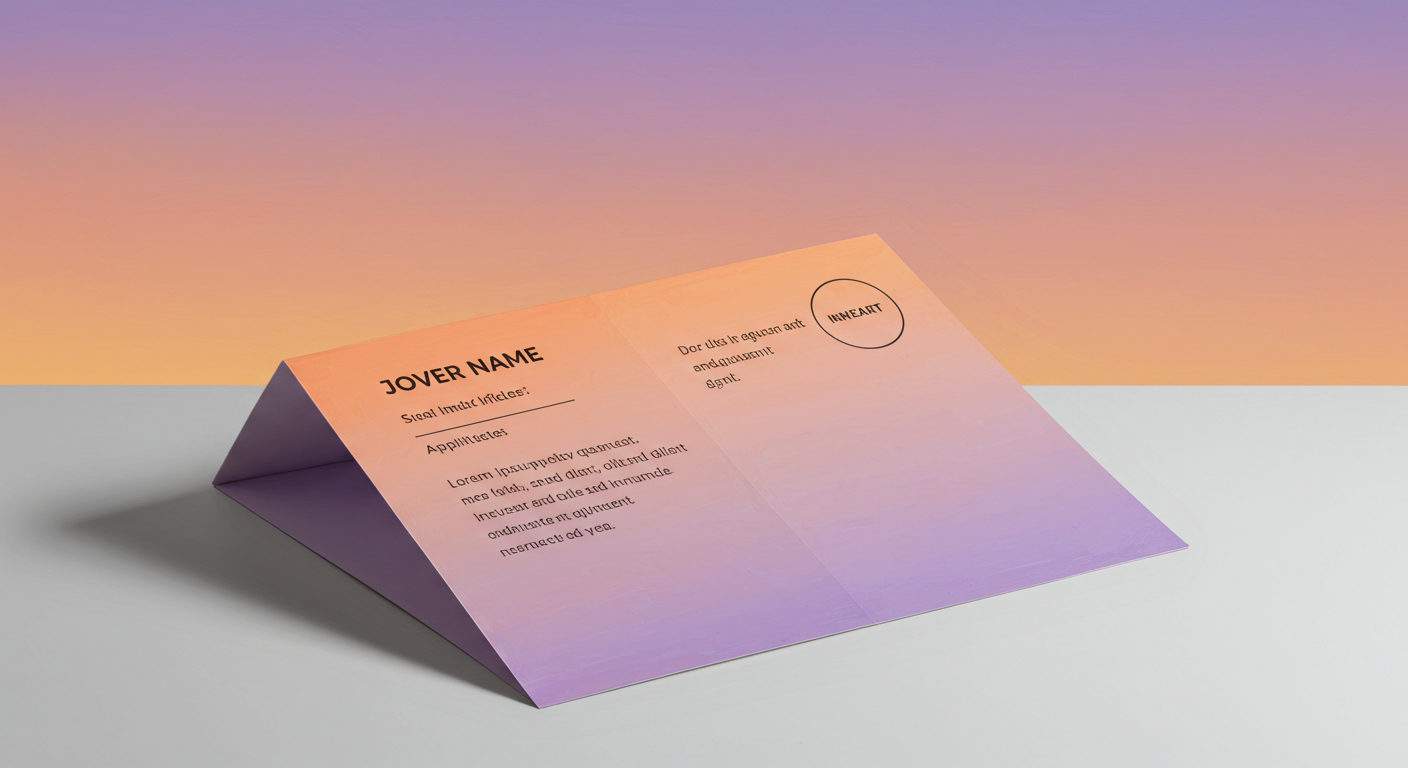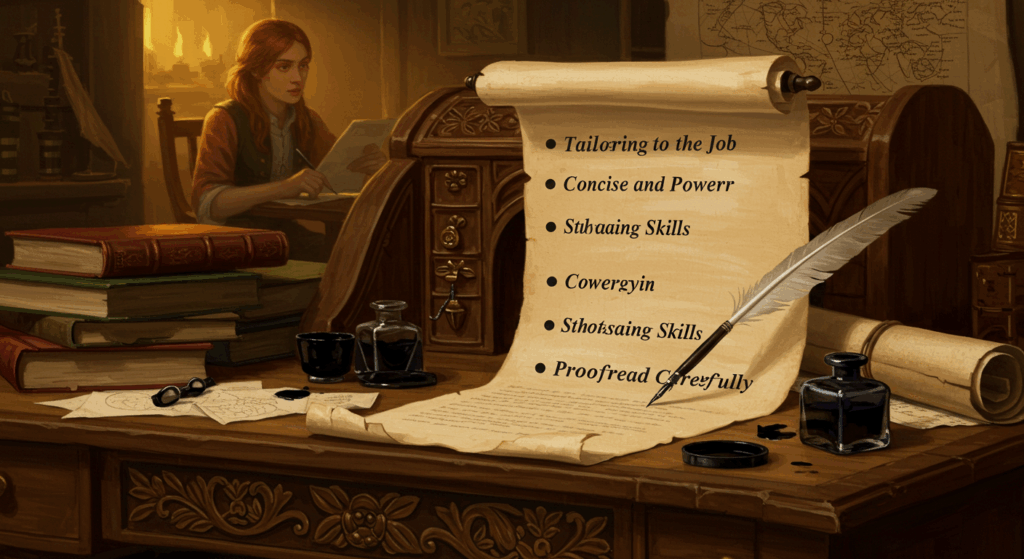You know that tiny message you paste into the email body or the little box on a company portal that says “message to employer”? That’s your cover note. It’s like the 30-second trailer before your full movie (your resume). And because attention spans are… well, TikTok-length, a good cover note can be the difference between “hmm, interesting—open” and “archive forever.”
In this guide, I’ll show you exactly how to write a cover note for a job application that feels human, sounds confident (not cringe), and makes hiring managers want to talk to you. We’ll talk introduction, content, closing (yup, those exact words), subject lines, examples for different situations, dos/don’ts, and quick templates you can copy. We’ll keep it conversational—like me texting you while doom-scrolling Netflix menus and pretending that counts as “watching something.”
Deep breath. Coffee sip. Let’s go.
Cover Note vs. Cover Letter (and When You Need Each)
A cover note is a short, punchy message—usually 100–200 words—sent in an email, portal message, or LinkedIn note. It spotlights your fit and tees up your resume/portfolio. Think: “elevator pitch, but typed.”
A cover letter is the full version (typically 3–5 short paragraphs, 300–500 words). Some portals literally ask for a cover letter upload. If they do, cool—give them the longer format. If they don’t, and you’re emailing or there’s a tiny text box, the cover note is perfect.
When to use a cover note:
- You’re applying by email and attaching a resume/portfolio.
- The portal gives a small text field (not a full upload spot).
- You’re DM’ing a recruiter on LinkedIn (or following up after a career fair).
- You’re getting a referral and want a crisp intro to forward.
TL;DR: If it’s short-form space, write a cover note. If they explicitly ask for a letter, write a cover letter. If you’re unsure, ngl, the cover note is safer than dropping a scary wall of text.
The Vibe Check: What Makes a Good Cover Note?
- Short. 100–200 words (max 250 if you’re ~dying~ to share one more flex).
- Friendly-professional. Not stiff, not slang soup. Human. Real voice.
- Company-specific. Show you actually read their job page, not just vibes.
- Outcome-oriented. Use mini wins with numbers (or strong outcomes) where possible.
- Clear ask. What do you want next? (A chat? To send more work? A quick call?)
And yes, we’re going to build it around introduction, content, closing so it flows.
The Simple Structure: Introduction, Content, Closing
Introduction: Hook Them (10–40 words)
Lead with something specific: role + why you’re reaching out + a quick “why them.” If there’s a referral, drop it here. If you’re a fan of their product or a recent company milestone, mention it in one clean line. No 3-sentence monologues—keep it snackable.
Formula:
“Hi [Name]—I’m a [your role/strength] applying for [role]. I love [specific thing about company/product/mission], and I’ve led [one-line impact] that maps to your needs.”
Content: Proof You’re a Match (60–120 words)
Two to three mini proof points. Each should mirror the job description’s must-haves. Use the STAR/CAR trick in micro-form:
- Situation/Challenge (tiny)
- Action (what you did)
- Result (numbers or outcomes)
Example bullets inside the paragraph (not a long bullet list):
“At X, I cut onboarding time 28% by redesigning the flow. At Y, I drove 3 product expwriments—one lifted activation 11%. I also set up a weekly KPI ritual so decisions were less vibes, more data.”
Closing: The Clear Ask (15–40 words)
Be specific about next steps. Offer time windows. Add links. Keep it breezy, not begging.
Example:
“Could we chat next week? I can share a 2-minute Loom on how I’d approach your onboarding flow. Tues–Wed 1–4pm works; happy to adapt.”
Bam. That’s introduction, content, closing in like 5 lines total.
Word Count, Tone, and Format (Without Overthinking)
- Length: 120–200 words is the sweet spot. Enough to show fit; short enough to read between sips of coffee.
- Tone: Confident, curious, not robotic. Think “first-date energy” (interested but not intense).
- Formatting: One short greeting, two slim paragraphs, one single-line closing. White space is your BFF.
- Keywords: Sprinkle role-specific keywords (e.g., “lifecycle marketing,” “Next.js,” “B2B SaaS,” “FP&A”). This helps internal search filters and shows alignment.
- Links: Attach a PDF resume; link to your portfolio/LinkedIn/GitHub. If you’ve got one perfect case study, link it.
Subject Lines That Don’t Scream “Mass Apply”
These are for email. If you’re in a portal, skip to the next section.
- Product Designer — Notion-level onboarding, shipped 3 flows at [PrevCo]
- Applying: Lifecycle Marketer — 11% activation lift w/ experiments
- Referral from [Name]: Data Analyst (SQL, dbt, Looker)
- Front-End (React/Next): cut LCP 38% on e-comm PDP
- Ops Lead — built hiring pipeline that trimmed time-to-fill 22%
Keep it honest. Lead with the role + one quantified win. If you’re early career, use skills + a project outcome (“Finance Intern — FP&A case w/ revenue model for campus startup”).
Grab-and-Go Templates (Fill-in-the-Blank)
1) General Cover Note (Introduction, Content, Closing)
Introduction
Hi [Hiring Manager Name]—I’m a [your role] applying for [job title]. I admire [specific product/mission], especially [brief detail they’ll recognize].
Content
Recently at [Company/Project], I [action + result with metric]. I also [second action + result], which maps to your need for [skill from JD]. Beyond the numbers, I’m known for [soft skill/working style] and I lean into [tool or method] to keep things measurable.
Closing
I’d love to share a brief walkthrough of how I’d tackle [1 job-specific challenge]. Are you open to a quick chat next week? Resume attached; portfolio/ GitHub: [link].
2) Referral Note
Introduction
Hi [Name]—[Referrer] suggested I reach out about [role]. I love that [company] is [specific thing].
Content
At [Company], I [action] that led to [result]. Previously, I [action] and drove [result]. I also set up [process/tool] that [impact]. These match your needs around [skills from JD].
Closing
Happy to hop on a quick call or send a 2-minute Loom with ideas for [challenge]. Thanks for considering—resume attached.
3) Career Switcher / “I Don’t Have the Exact Title (Yet)”
Introduction
Hi [Name]—I’m pivoting from [previous field] to [target field] and applying for [role]. I’ve completed [course/cert/project] and built [relevant deliverable].
Content
In my last role, I [transferable action], which maps to [skill in target role]. In my portfolio, you’ll see [project] where I [action] and achieved [result]. I’ve also been using [tools/stack] daily for [duration].
Closing
Could we chat? I’d love to walk you through how I’d approach [company-specific challenge]. Portfolio: [link].
4) New Grad / Intern
Introduction
Hi [Name]—I’m a [major/year] at [school], applying for [role]. I’m obsessed with [industry/product] and just built [project] that [result].
Content
On [team/club/course], I [action] and [result]. I know [tools/skills]. I’m the person who [soft skill], and I love structured feedback + fast iteration (seriously, roast my code/designs).
Closing
I’d love to contribute this summer. Can we connect for a quick chat? Resume attached; projects: [link].
5) LinkedIn InMail (Super Short)
Introduction
Hi [Name]—I’m a [role] who’s shipped [1-line win] and I’d love to apply for [role] at [company].
Content
I’ve done [skill] with [tools], recently [result]. Your need for [skill from JD] = my jam.
Closing
Open to a 10-min chat? Happy to send a 2-min Loom. Thanks!
Example Cover Notes You Can Literally Copy (Then Tweak)
Example A: Product Designer (SaaS)
Subject: Product Designer — onboarding wins (28% time-to-first-value cut)
Introduction
Hi Maya—applying for Product Designer at BlueKite. I’m a fan of your lean release notes and the way you dogfood new flows (genuinely rare).
Content
At Sproutly, I redesigned onboarding and cut time-to-first-value by 28% in two sprints by simplifying choices and adding empty-state education. Earlier, I led a billing revamp that reduced support tickets 19%. I partner tightly with PM + Eng, prototype in Figma, and validate with quick mixed-method tests so we’re building value, not just pixels.
Closing
Could we chat next week? I can share a 2-minute Loom of how I’d approach your “Connect Data” step. Resume attached; portfolio: [link]. Thanks!
Example B: Data Analyst (e-commerce)
Subject: Data Analyst — SQL/dbt/Looker | +13% checkout conversion insight
Introduction
Hi Daniel—throwing my hat in for Data Analyst. Love how Rivet’s blogs unpack experiments with actual confidence intervals (chef’s kiss).
Content
At Northlane, I built a dbt model to unify clickstream + orders; the insight on promo stacking led to a pricing tweak and +13% checkout conversion. I also set up Looker dashboards for retention cohorts and a weekly readout that shaved report requests by ~40%. Tools: SQL, dbt, Looker, BigQuery, Python.
Closing
Happy to walk through a quick case. Are you free Wed/Thu afternoon? Resume attached; GitHub/portfolio: [link].
Example C: Career Switch (Sales → Customer Success)
Subject: Customer Success — ex-AE who scaled NPS + playbooks
Introduction
Hi Priya—I’m pivoting from AE to Customer Success and applying for your CSM role. I admire your “no throw-it-over-the-wall” handoff philosophy.
Content
As an AE at BrightArc, I inherited churn-risk accounts and created a success playbook for renewal prep; we lifted NPS from 31→45 in a quarter. I’ve led cross-functional “voice of customer” syncs and built a light QBR template that reduced renewal surprises. I’m comfortable with Gainsight, HubSpot, and CSQL ops.
Closing
I’d love to show you the playbook. Could we chat? Resume attached; case study (sanitized): [link].
Example D: New Grad (Software Engineer)
Subject: Software Engineer (New Grad) — Next.js + Rust side project
Introduction
Hi Jorge—I’m a CS senior applying for SWE. I’m impressed with how Zephyr adopted edge functions for speed (I… may have read your engineering blog too much).
Content
My capstone team built a Next.js + Rust service for event ingestion (Rust because… fun) and hit p95 under 120ms on a titchy budget. I’ve interned at Pico Labs (TypeScript + Playwright) and enjoy code reviews—give me notes, I’ll fix it fast. Comfortable with Postgres, Redis, and Docker.
Closing
Open to a quick chat? I can share a short Loom on scaling our ingestion pipeline. Resume attached; GitHub: [link].
How to Mirror the Job Description (Without Copying It)
- Highlight 2–3 must-haves from the JD. If it screams “SQL + stakeholder comms + dashboarding,” that’s your content core.
- Translate your wins into their language: if they say “activation,” don’t call it “first aha.” Call it activation (then maybe parenthetical “time-to-aha” if helpful).
- Add one micro-insight about their product/market so your introduction feels custom (try their product demo, scan recent release notes, or read their docs).
- Close with a specific next step relevant to their role (e.g., “I can sketch a first-pass schema,” “happy to audit your top-of-funnel email”).
Using Introduction, Content, Closing in Different Scenarios
Cold Email to a Hiring Manager
- Introduction: Who you are + one specific company detail.
- Content: Two impact lines mapped to the JD.
- Closing: Ask for a short chat and propose a tiny value add (Loom, audit, mini wireframe).
Portal “Message to Employer”
- Introduction: Role + one detail about product/mission.
- Content: One strong accomplishment + one transferable skill.
- Closing: “Resume attached; portfolio: [link]. Available next week to chat.”
LinkedIn DM
- Introduction: Role + a one-liner on why them.
- Content: One win, one skill match.
- Closing: “Open to a quick chat?” (Keep it under 75 words.)
Mini Phrases Bank (So You Don’t Stare at a Blank Box)
- “I’m applying for [Role]—your focus on [initiative] is exactly where I’ve shipped wins.”
- “Recently, I [action], which led to [impact metric].”
- “I love building [X] with [tools/methods] and validating with [user testing/data].”
- “Happy to share a 2-minute Loom on how I’d approach [challenge].”
- “Resume attached; portfolio/GitHub: [link].”
Common Mistakes (and How to Fix Them Fast)
- Vague fluff.
“I’m a hard worker and team player.”
→ Fix: “I facilitated weekly post-mortems that cut recurring bugs 23%.” - Novel-length intros.
You don’t need your entire life story before breakfast.
→ Fix: One line that shows why them + who you are. - Zero next step.
They don’t know what you want.
→ Fix: “Could we chat next week? I can walk through how I’d improve X.” - Copy-paste energy.
“Dear Sir/Madam, to whom it may concern, I love your esteemed…”
→ Fix: Use a real name. Reference a real feature/post/release. - Metrics panic.
No numbers? You have utcomes.
→ Fix: Time saved, steps removed, satisfaction raised, errors reduced, money protected, speed improved—pick something measurable-ish.
Micro Frameworks You Can Steal
- CAR (Challenge–Action–Result): “Checkout drops at promo step → Reworked flow → +13% conversion.”
- STAR (Situation–Task–Action–Result): Useful for slightly longer content sentences.
- XYZ Formula: “Achieved X by doing Y, resulting in Z.”
Example: “Cut LCP 38% by preloading hero assets, improving PDP conversion 6%.”
Keep each proof point one line. This is a cover note, not a TED talk.
Formatting Tips That Quietly Matter
- Greeting: Use their name if possible (“Hi Maya”). If truly unknown: “Hi Hiring Team at [Company].”
- File names:
Firstname_Lastname_Resume.pdfandFirstname_Lastname_Portfolio.pdf. Notfinal_final_RESUME(2).pdflol. - Links: Make them obvious; don’t hide your only portfolio link inside a random word like “here.”
- Readability: 2–3 sentences per paragraph. White space = kindness.
- Emojis? Light touch only if the culture fits and it’s a DM. In email/portal, skip.
- Time zones (remote roles): Offer yours; show flexibility. (E.g., “I’m GMT+7 but happy to overlap 9am–1pm PT.”)
Quick Checklist Before You Hit Send
- Did my introduction name the role and one specific company detail?
- Did my content include 2–3 job-aligned wins (ideally with metrics)?
- Did my closing ask for a clear, reasonable next step?
- Is it under 200 words?
- Do I have the right attachments and links?
- Did I use the hiring manager’s name (or at least the company’s)?
- Any typos? (Some casual vibes are fine—just don’t write “pubic relations.” It happens. Tragically.)
FAQs You Might Be Low-Key Thinking
Is a cover note required?
Not always. But sending one, especially in an email or small portal box, shows you’re intentional. It frames your resume and boosts reply odds.
How many paragraphs?
Two or three very short ones: introduction, content, closing. That’s it.
What if I have no metrics?
Use outcomes beyond numbers: faster, cleaner, fewer steps, clearer, more consistent, reduced back-and-forth, improved satisfaction.
Can I paste a full cover letter?
If the field is tiny, no. If they ask for a letter upload, yes. Otherwise, keep it cover-note length.
Do I need to mirror their tone exactly?
Align, but don’t cosplay. If they’re playful, you can be a bit playful. If they’re stoic/regulated (fintech, healthcare), tighten up.
“Before and After” Glow-Up (So You Can See the Difference)
Before (meh):
Dear Sir/Madam,
I’m applying for the Marketing Manager role. I have many years of experience in marketing and I am a hardworking team player. I believe I can help your company grow. Please consider me.
After (clean):
Hi Jordan—applying for Marketing Manager. I’m excited about Loomly’s focus on lifecycle; I led two onboarding experiments at Folio that lifted activation 11% and cut churn 6% for new users.
I’ve built multichannel campaigns (email/in-app/paid) and a weekly KPI rhythm to keep tests disciplined. I’m hands-on with Braze + Amplitude and love partnering with PM to turn insights into shipped changes.
Open to a quick chat? I can share a 2-minute Loom with how I’d prioritize your first 90 days. Resume attached.
Notice the introduction says why them, the content proves fit with specifics, and the closing asks for a call with a tiny value add.
Tiny Personalization Sparks (That Take < 5 Minutes)
- Name-drop a recent product update you tried.
- Reference a podcast/blog post by their CEO/Head of X.
- Mention a customer segment they’re chasing (“mid-market, not SMB—smart move”).
- Point to a metric they likely care about (“activation, not vanity signups”).
One line is enough. You don’t need to become their biographer.
If You’re Applying in Bulk (But Want to Sound Custom, Not Like Spam)
Create a base note (50–60%) and a slot for customization (40–50%). The customized parts are:
- Company-specific reason in the introduction.
- Two skills pulled from their JD woven into the content.
- One tiny offer tailored in the closing.
Save a few versions (design, data, PM, ops) so you can swap fast without sounding like you wrote to “Acme Inc.” and forgot to change the name (we’ve all done it… once).
A Few More Full Examples by Role
Ops / Generalist
Introduction
Hi Kim—applying for Operations Associate at Ledgerly. Your playbook on low-friction vendor onboarding is so clean, wow.
Content
At Pearl, I cut time-to-invoice 35% by automating doc intake and setting SLAs in Notion + Zapier. I also built a hiring pipeline tracker that trimmed time-to-fill 22% (less chaos, more clarity). I enjoy tearing down messy processes and shipping pragmatic fixes.
Closing
Could we chat for 15 minutes? Happy to share a 1-pager of ops wins. Thanks!
Customer Support → Support Lead
Introduction
Hi Ayana—I’m applying for Support Lead. I love how Cedar treats support as part of the product experience, not an afterthought.
Content
At Trace, I coached 8 reps and launched a macro library that dropped handle time 18% without hurting CSAT (held ~4.7/5). I partnered with Product to tag issues and reduced repeat contacts ~12% by improving our “first-response education.”
Closing
I’d love to walk through playbooks and coaching rhythms. Free Tue/Thu afternoons. Resume attached.
Content Marketer
Introduction
Hi Ben—I’m applying for Content Marketer. Your docs + blog balance personality with clarity (harder than it looks).
Content
At Teal, I owned a 3-stage funnel that took two features from zero to 12k monthly organic clicks in ~6 months (topic clusters + product-led tutorials). I write fast, edit faster, and work well with SMEs without fluff.
Closing
Open to a quick call? I can send 3 links that map to your ICP. Thanks!
Final Polish: Tiny Edits That 10x Clarity
- Change “responsible for” → “shipped/led/built.”
- Change “helped with” → “co-owned/launched/implemented.”
- Change “various tasks” → name 2–3 specific things.
- Replace passive voice (“was involved in”) with active (“ran,” “built”).
- Swap “passionate” for 1 concrete action you took outside work (project, course, contribution).
Yes, these are small. But small is the whole point of a cover note.
A Quick, Complete Example You Can Model
Subject: Growth Marketer — activation +11%, lifecycle experiments
Introduction
Hi Tori—I’m applying for Growth Marketer. I’m into how Juno ties onboarding to product education (not just a confetti modal, lol).
Content
At Karo, I led lifecycle tests across email + in-app and lifted activation 11% in a quarter by segmenting new users into “learners” vs. “doers” and adjusting nudges. Before that, I set up a weekly KPI review and sunsetted low-impact messages (we reduced send volume 23% with zero negative impact—bless). Tools: Braze, Amplitude, Segment; I write my own briefs and partner closely with design and PM.
Closing
Could we chat next week? I can send a 2-minute Loom outlining a 30-day test plan for your new checklists feature. Resume attached; portfolio: [link]. Thanks!
Okay, Real Talk: Confidence Without Being Weird
You can be warm and a little playful, but remember it’s a workplace note. A single “haha” or “lol” to soften an observation is fine; ten of them is a group chat. Sprinkle, don’t pour. If you’re unsure, write it straight, then add one friendly aside (“happy to adapt on timing,” “I can share a tiny Loom”) so you still sound human. And if you typo one harmless word—hey, it happens (definitley not me…). Just keep it readable.
The One-Page Cheat Sheet (Bookmark This)
- Introduction: role + 1 legit company detail (or referral).
- Content: 2–3 wins that mirror the JD (use CAR/STAR/XYZ).
- Closing: clear ask + optional tiny value add (Loom, audit, sketch).
- Length: 120–200 words.
- Files/Links: resume attached; portfolio/GitHub/LinkedIn visible.
- Style: friendly-professional; short paragraphs; white space.
- Personalize: one line about product/mission/feature.
- Send: strong subject line with a role + one outcome.
That’s it. That’s the game.
Wrap-Up (You’ve Got This)
Writing a great cover note isn’t about sounding fancy; it’s about making it easy for a busy human to say, “Yeah, let’s talk.” Keep it short. Make it specific. Show how your content lines up with their needs. Nail the introduction, slip in 2–3 proof points, and finish with a crisp closing that suggests the next step. Done. Ship it.









